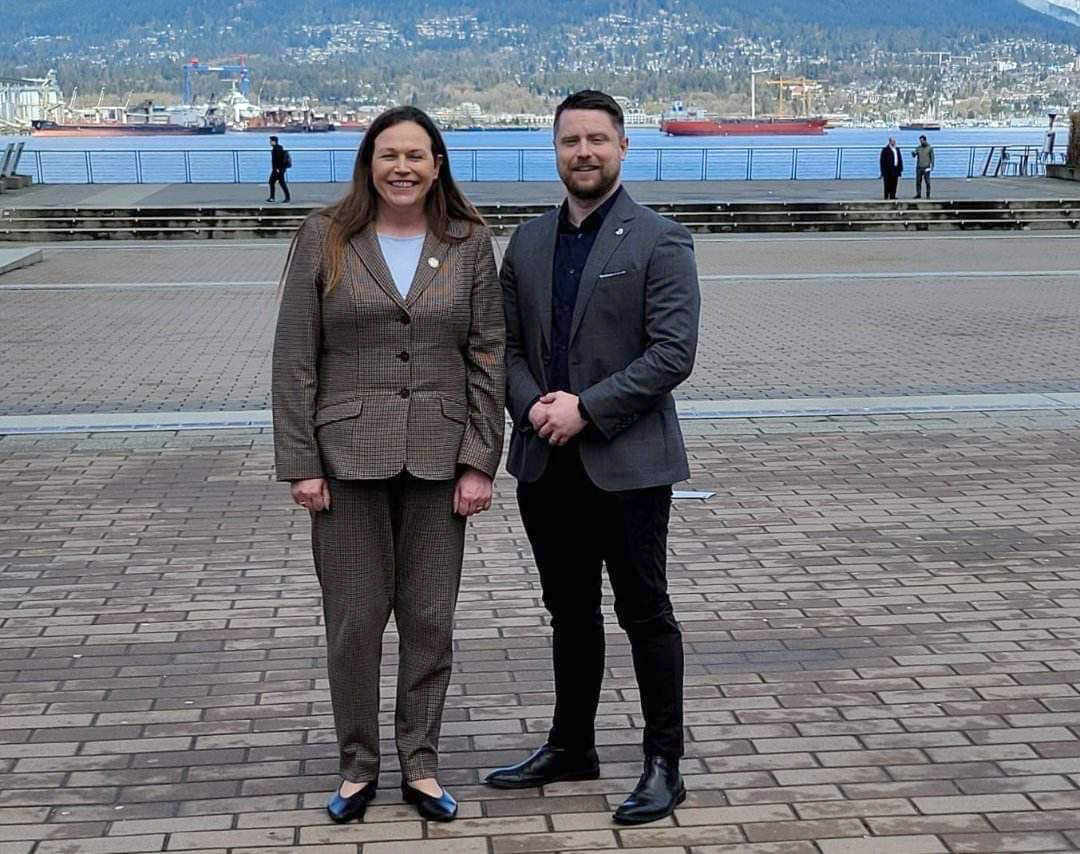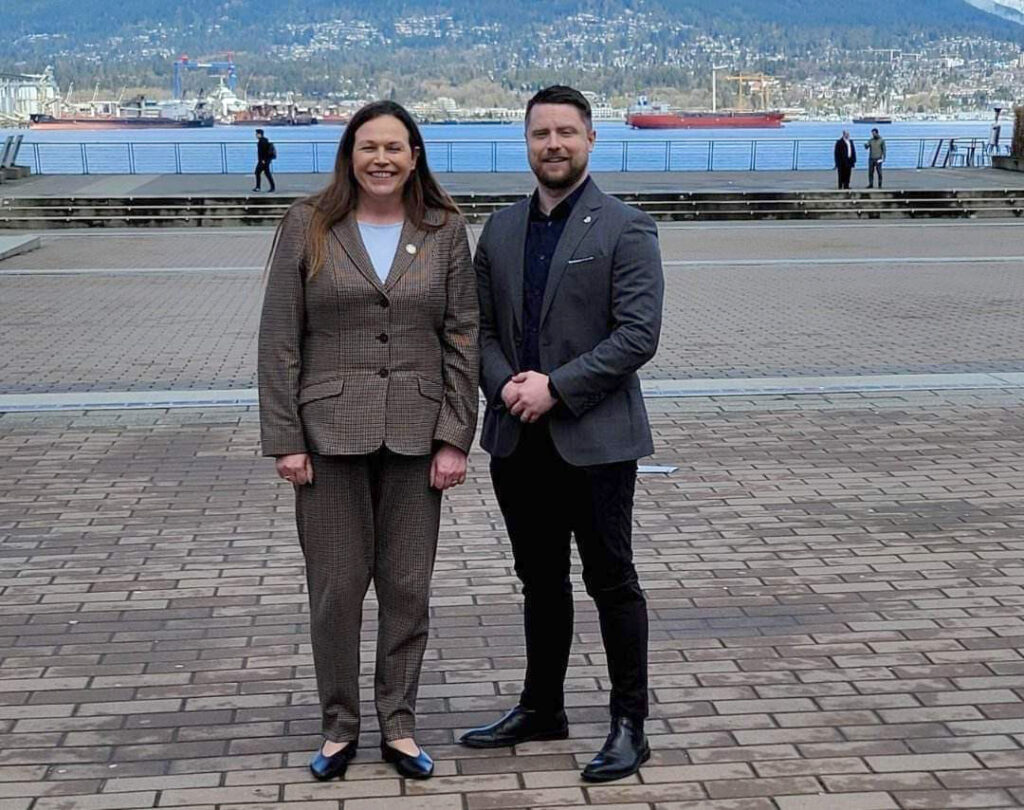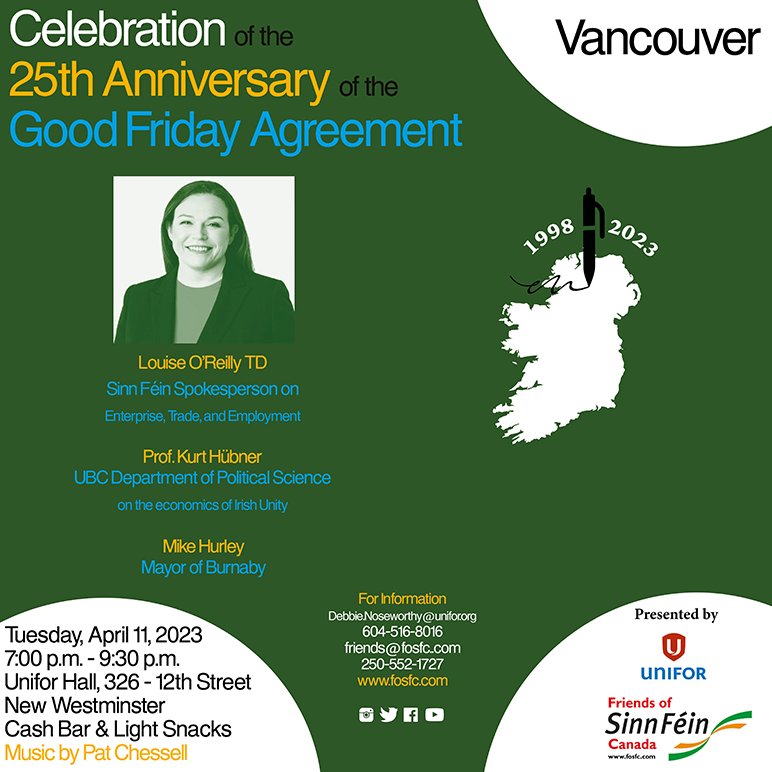
Bob Mackin
A touring Irish politician said the sudden benefit of the landmark peace and power-sharing agreement 25 years ago this week was the world seeing images of co-operation instead of conflict.

Irish politician Louise O’Reilly (left) with Michael Murphy, president of the Ireland-Canada Chamber of Commerce Vancouver. (@LoreillySF/Twitter)
The Good Friday Agreement of April 10, 1998 between politicians in Northern Ireland and the leaders of the Republic of Ireland and the United Kingdom helped end a period of more than 30 years of sectarian violence that took 3,700 lives. Voters in the mainly Catholic republic and mainly Protestant north ratified the agreement six weeks later, on May 22, 1998.
“People turned all of their eyes to Dublin and Belfast in a really positive way,” Louise O’Reilly, a Sinn Fein member of the Irish parliament, said during an interview April 11. “And it was like, ‘look what the Irish are doing there, look how they are building peace.’ It showcased the island of Ireland in a fantastic and positive way.”
O’Reilly, twice elected in the Dublin Fingal riding, is her party’s critic for workers’ rights, enterprise, trade, and employment. She appeared at a forum in New Westminster, with Burnaby Mayor Mike Hurley, during her tour to celebrate the agreement’s 25th anniversary. Sinn Fein is the left-wing republican party once considered the political wing of the Irish Republican Army. The IRA’s 1997 ceasefire opened the door for then-Sinn Fein president Gerry Adams to join peace talks.
In April 1998, O’Reilly was living in Dublin’s inner city with her husband and their two-and-a-half-year-old daughter. She remembers the tense final days of talks.
“When [American envoy] George Mitchell said, ‘I’m going home for Easter lads, this is either getting done, or we lose this momentum’,” she said. “Just to see them seize the momentum and get it over the line at the last minute.”
O’Reilly grew up in Dundalk, the Irish town halfway between Dublin and Belfast that U.S. President Joe Biden visited on April 12. The daughter of a union organizer who became a union organizer herself, O’Reilly remembers enduring 90-minute long lineups at the border, seven kilometres from Dundalk, just to go swimming in Northern Ireland.
“That’s not there anymore, there’s seamless travel, and seamless trade across the border and it has benefited the north,” she said.
Despite skeptics, the deal has endured and paid dividends, including for the so-called “Good Friday generation,” those born 1998 onward, who only hear of the conflict from their parents and grandparents. “They get to live their life in peace. That, you can’t put a price on that.”
Hurley, who hails from Magherafelt in Northern Ireland, agrees. He moved to Canada in 1983 as a musician and later became a firefighter. He was a 10-year-old in 1969 and remembers his aunt in Belfast being burned out of her home.
 “Through the eyes of the child at that time, it was terrifying,” Hurley said. “Because you didn’t know what was coming next.”
“Through the eyes of the child at that time, it was terrifying,” Hurley said. “Because you didn’t know what was coming next.”
Since 1998, Belfast has spawned an international film industry, driven by the success of Game of Thrones, and realized tourism spinoffs. Foreign direct investment and post-secondary education have boomed on both sides. Since Brexit, Ireland is the only primarily English-speaking state in the European Union and Northern Ireland has been able to negotiate a special status to avoid the return of a hard border.
Sinn Fein has proposed the Dublin government set-up a citizens’ assembly to study unifying the 26 counties in the republic with the six in the north. Hurley called the 1998 agreement the first big step toward real democracy on the island of Ireland and unity would be the next logical step, if done right.
“The economics as they are right now don’t make any sense at all, for such a small island,” he said.
In “Modelling Irish Unification,” University of B.C. political science professor Kurt Huebner analyzed a scenario whereby the tax system is harmonized, trade barriers reduced, government duplication eliminated, the north adopts the Euro and the republic assumes the north’s deficit. Huebner estimated in 2015 that uniting Ireland would grow its GDP by €32.5 billion (or $48 billion) eight years after unification.
Hurley points to the establishment of the Ireland-Canada Chamber of Commerce Vancouver in 2017 and Irish Consulate in 2018 as local legacies of the 1998 deal.
The 2021 census estimated 627,000 British Columbians have Irish background. Before the pandemic, B.C. exported $19.3 million of goods annually to Ireland, almost half of which were measuring or checking instruments, appliances and machines. Dublin was the first stop of then-Jobs, Economic Recovery and Innovation Minister Ravi Kahlon’s European trade mission in May 2022. He met with government and industry officials about food and horticulture, biotech and mass timber.
Just like B.C., however, O’Reilly said housing affordability is a crisis in Ireland, a significant impediment to trade and retaining the young, educated workforce.
“We can’t simply go, ‘we’ve made it to 25 years now, pat on the back, didn’t we do well?’” she said. “It’s about looking forward, and for us, we’re looking forward to the prospect of a unity referendum, north and south, in the next 10 years.”
Support theBreaker.news for as low as $2 a month on Patreon. Find out how. Click here.











